
Foto de portada: Arte obra de Augusto Ferrer Dalmau
For an English version of this article, please scroll down
1. Jornadas Batalladores 2023
‘El Colapso’ es un wargame o juego de simulación histórica con un diseño como juego estratégico para 2 jugadores sobre la guerra de los 30 años (1618-1648), pero con reglas para poder realizar partidas multijugador que se puede reservar sin compromiso en el link http://tinyurl.com/yfkkdbc3
En las pasadas jornadas de Batalladores celebradas en la preciosa ciudad de Zaragoza entre el 3 y el 5 de Noviembre que organizó el club Batallador para alrededor de 300 asistentes y que disfrutamos con tantos juegos, presenté las novedades de ‘El Colapso’ así como el juego de ‘La Defensa-El Asedio de Cádiz 1625’. El juego de ‘La Defensa’ lo diseñé con el fantástico arte de Nils Johansson que entregamos gratuitamente con Sergio del blog Mesa de Guerra en las pasadas jornadas de Pax Lúdica 2023, y que estamos trabajando en una edición para el público en general.

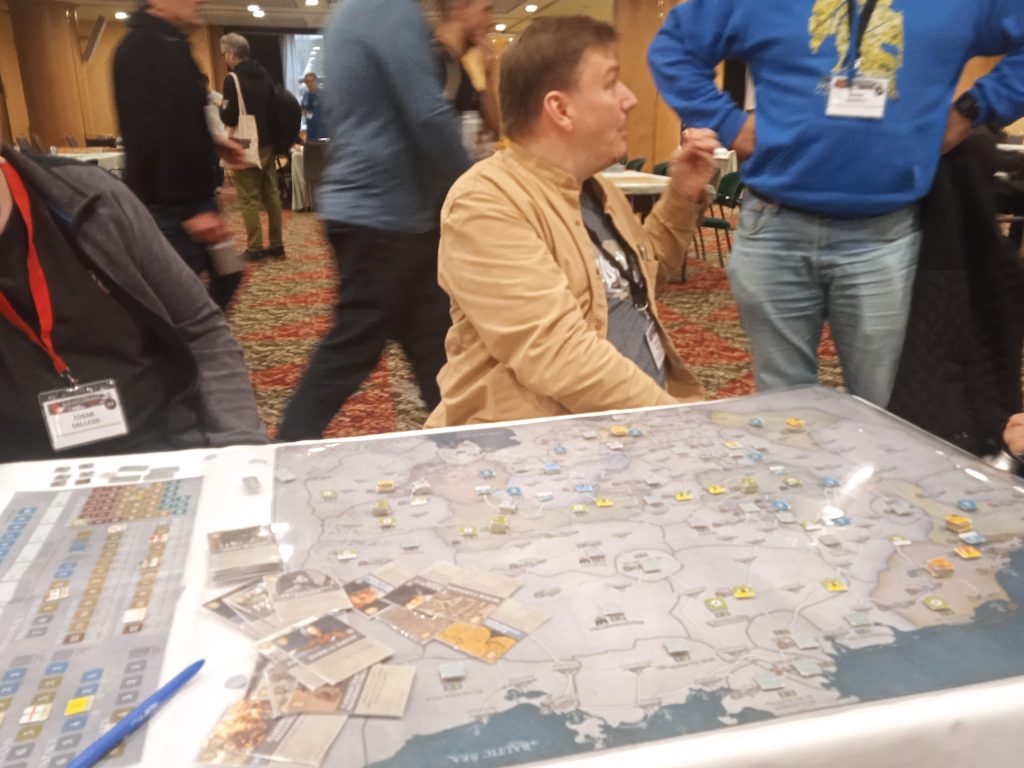

Fotos de Batalladores 2023
En Batalladores 2023 presenté las novedades de ‘El Colapso’ que se encuentra en un estado de prototipo avanzado, con las mecánicas listas a falta de unos últimos ajustes y seguir ajustando valores con el testeo tanto en persona como en vassal principalmente de la campaña entera (10 turnos). Entre otras novedades presentadas, destaco la actualización del arte del maravilloso artista gráfico del juego Donal Hegarty del mapa, tablero diplomático-administrativo, cartas y fichas.
Os recomiendo para quien queráis conocer más del juego que veáis los últimos vídeos que grabé sobre el juego con:
- Gostilian: https://www.youtube.com/watch?v=SHAKpExFmCw&t=475s
- El Profe Bermejo:
(vídeo parte 1) https://www.youtube.com/watch?v=g3wBYqRM1-8&t=51s
(vídeo parte 2) https://www.youtube.com/watch?v=DYN-L3WdOH0&t=499s
También se pueden encontrar estos vídeos y otros anteriores junto más información en la página de la BGG que os recomiendo visitéis en: https://boardgamegeek.com/boardgame/389679/collapse
2. Partida de ‘El Colapso’ en Batalladores 2023

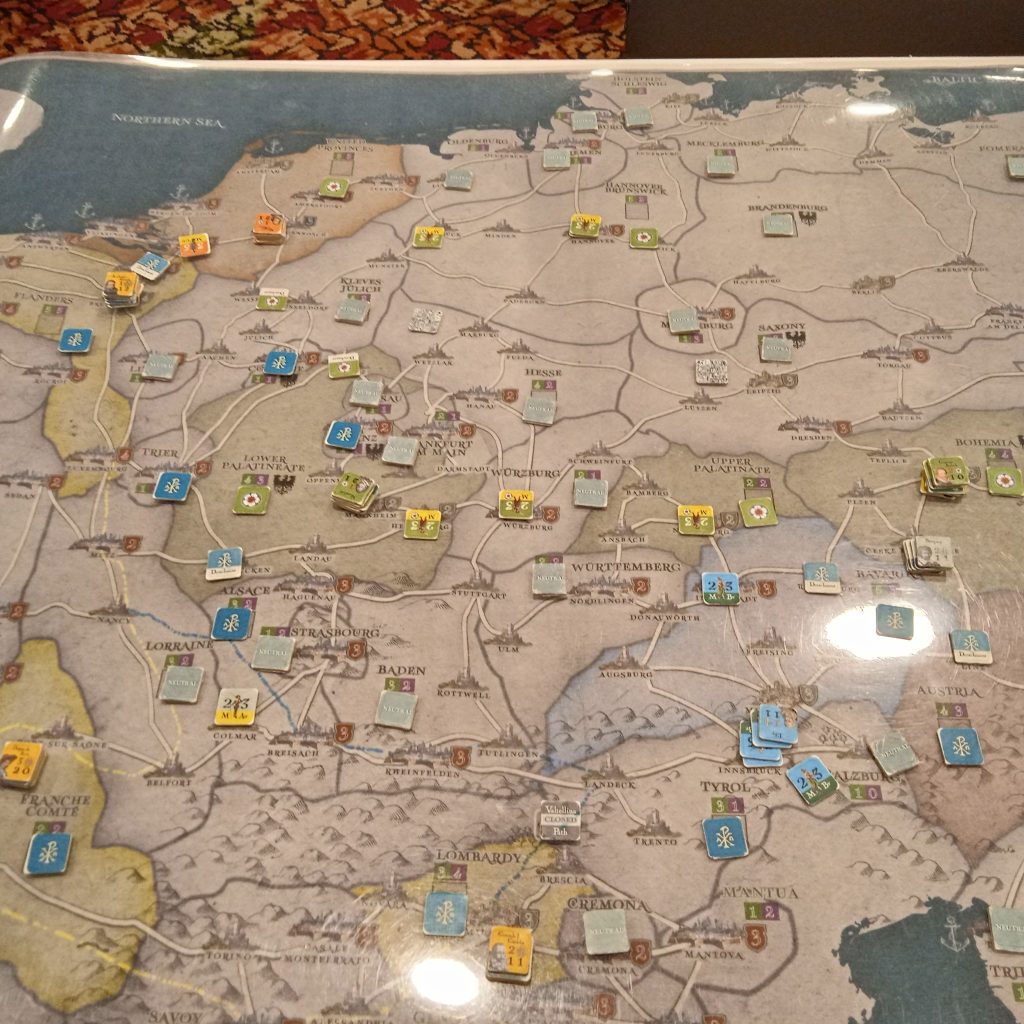
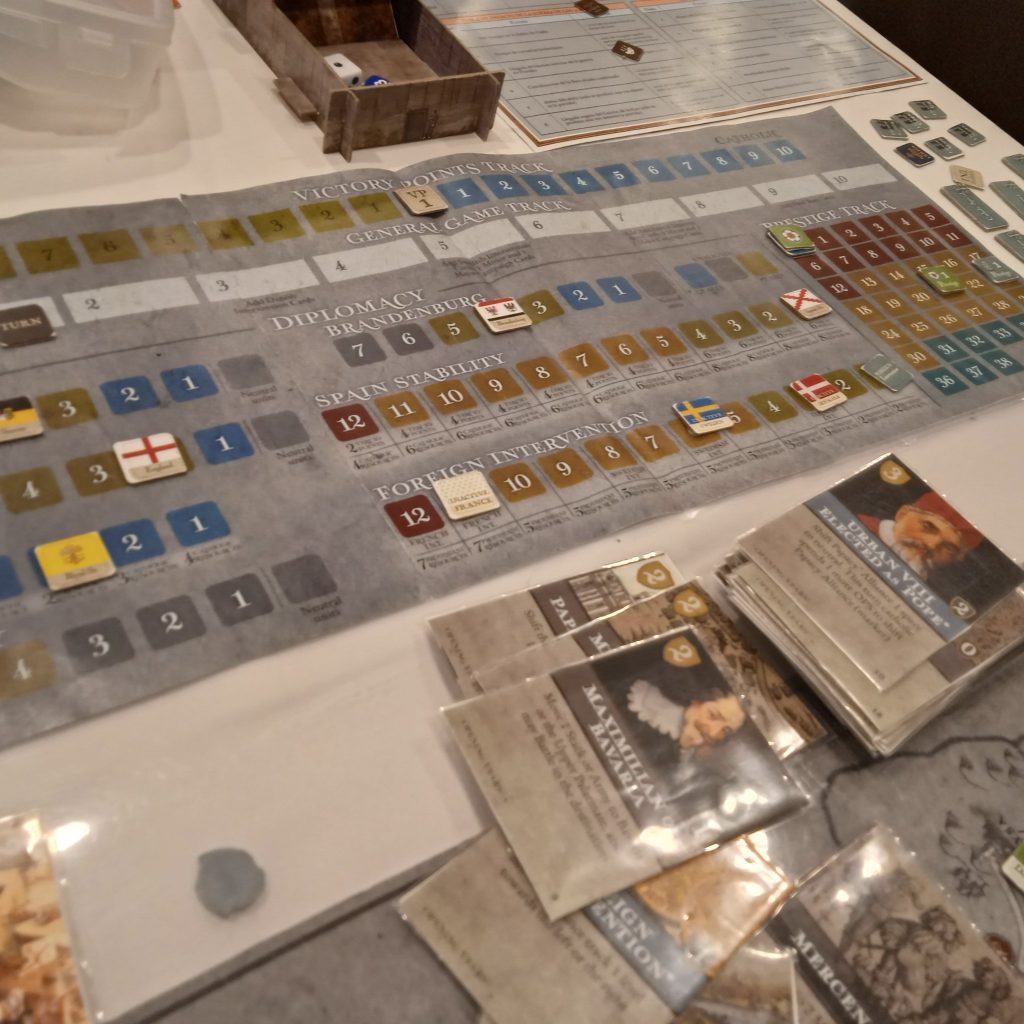

Fotos de ‘El Colapso’ en Batalladores 2023
Durante las jornadas de Batalladores 2023 realicé varias partidas de demostración de ‘El Colapso así como responder a preguntas y gente interesada en el juego, pero más importante todavía fue el sábado cuando realizamos una partida multijugador con 6 personas (que será un modo de juego incluirá ‘El Colapso’).
TURNO 1
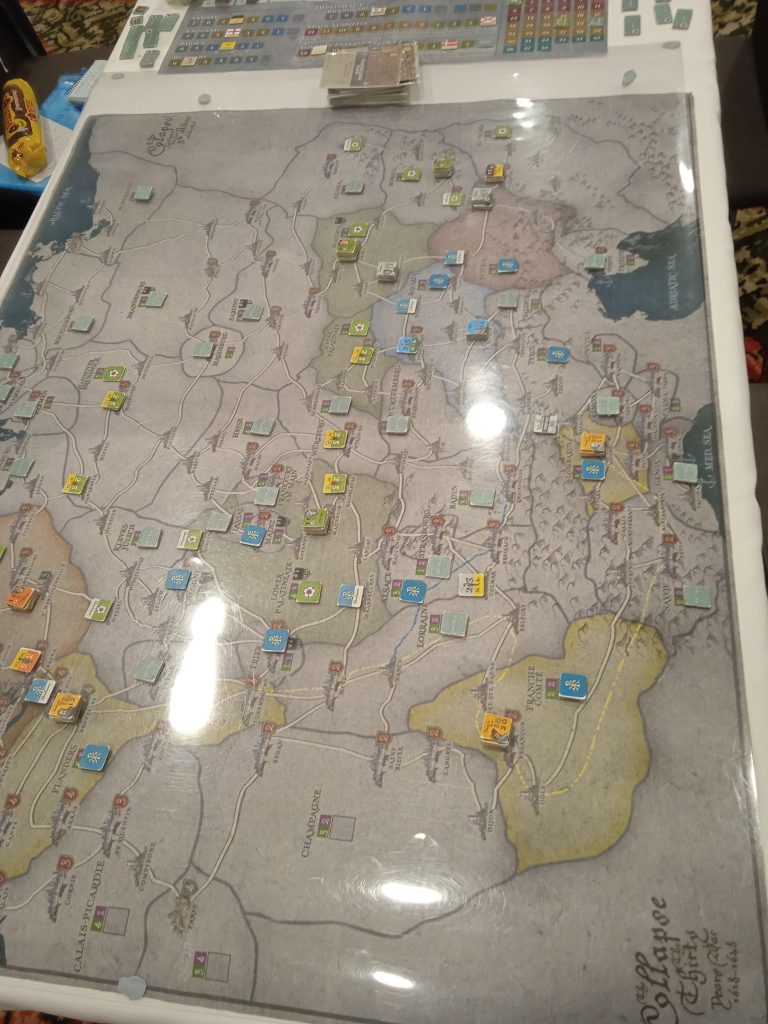
Inicio del turno
En el primer turno de la partida, mostré el funcionamiento del juego introduciendo progresivamente las reglas del juego como he incluido en los diferentes escenarios de aprendizaje del juego. El objetivo de esta acción era ayudar a que se pueda entender mejor su funcionamiento y poder jugar y divertirse con el juego, pero integrando las acciones y operaciones del juego de manera progresiva para que los jugadores entiendan mejor las reglas mientras juegan. A partir del turno 2 que explico seguidamente, los jugadores realizaron sus acciones por ellos mismos y tan sólo consultándome dudas.
En el inicio del turno se ve la situación inicial de las dos facciones donde el Protestante tiene mayor control de las líneas interiores (pero son ejércitos más débiles), y el Católico está situado en regiones más exteriores y separadas (pero sus ejércitos son más fuertes).
TURNO 2
Fase de Planificación
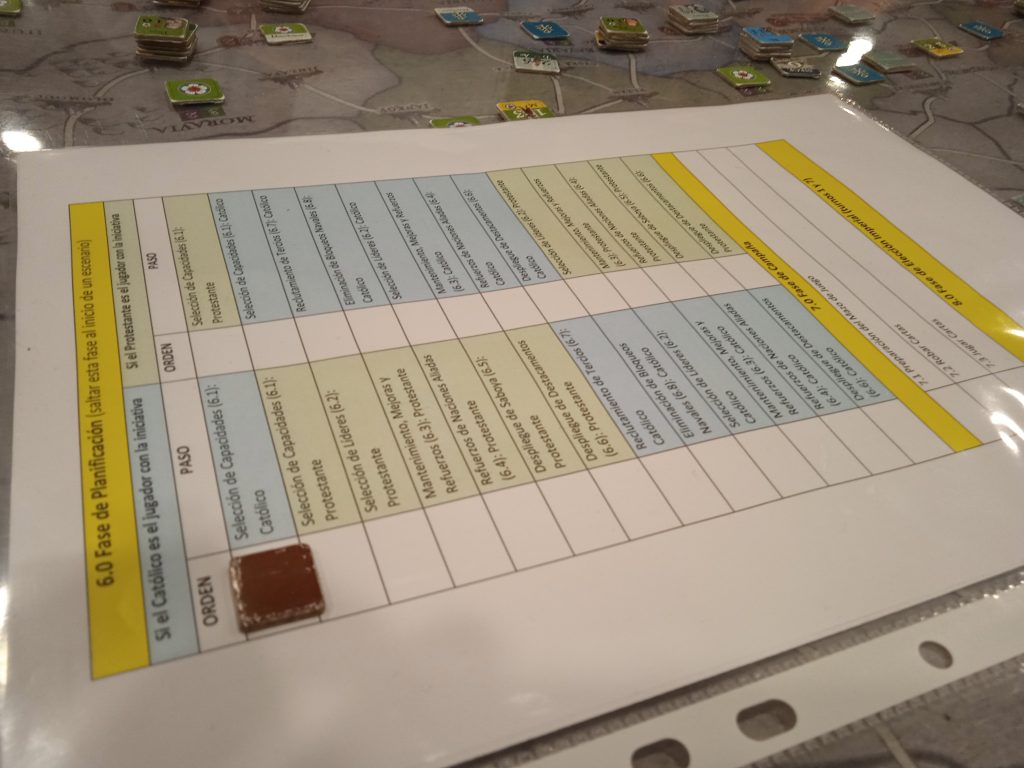
Hoja de ayuda de seguimiento de la fase de planificación (material de testeo)
En esta fase de inicio del turno (fase de planificación), los jugadores determinan las acciones que realizan según quien tiene la iniciativa del turno que en este caso es del Protestante (el marcador de puntos de victoria al final del turno anterior estaba a favor del Católico). Esta es una mecánica de compensar ligeramente el turno anterior, y tener la iniciativa en este paso y posteriormente decidir si quiere iniciar sus acciones en la fase de campaña o prefiere que sea el jugador contrario.
En cada paso de esta fase como se indica en la hoja de ayuda se realizan las acciones indicadas según el nivel de prestigio adquirido el turno anterior (bajo, medio o alto), que determinan cuantas acciones de pueden escoger en cada paso. Por ejemplo, si se tiene un prestigio medio en el paso de selección de líderes se podrá elegir 1 líder para entrar en juego, pero si está en bajo ninguno y en alto 2 líderes.
Fase de campaña
Después de repartir 6 cartas a cada jugador, el Protestante al tener la iniciativa del turno decide iniciar las acciones jugando primero. En este apartado expondré las acciones más destacadas del turno de ambos jugadores, para que podáis ver de una manera ágil e interesante el funcionamiento del juego y en un próximo artículo expondré una partida más larga.
A. Entrada de Dinamarca en el juego
El jugador Protestante en sus acciones decide usar una operación de diplomacia (coste de 2 puntos de operaciones de la carta) y mover el marcador de la intervención extranjera un espacio del 2 al 3 (en el turno anterior se había movido del 1 al 2). En este caso se llega a la casilla donde se encuentra la alianza de Dinamarca, y esas unidades (el líder Cristian IV, 4 tropas de Dinamarca y 2 mercenarios protestantes) entran en el mapa. En este caso se cumple la primera opción de entrada de tropas danesas según el reglamento, y entran en Kiel donde se toma control de la región del juego de Holstein-Schleswig (ajustando los puntos de victoria y de prestigio por su control).
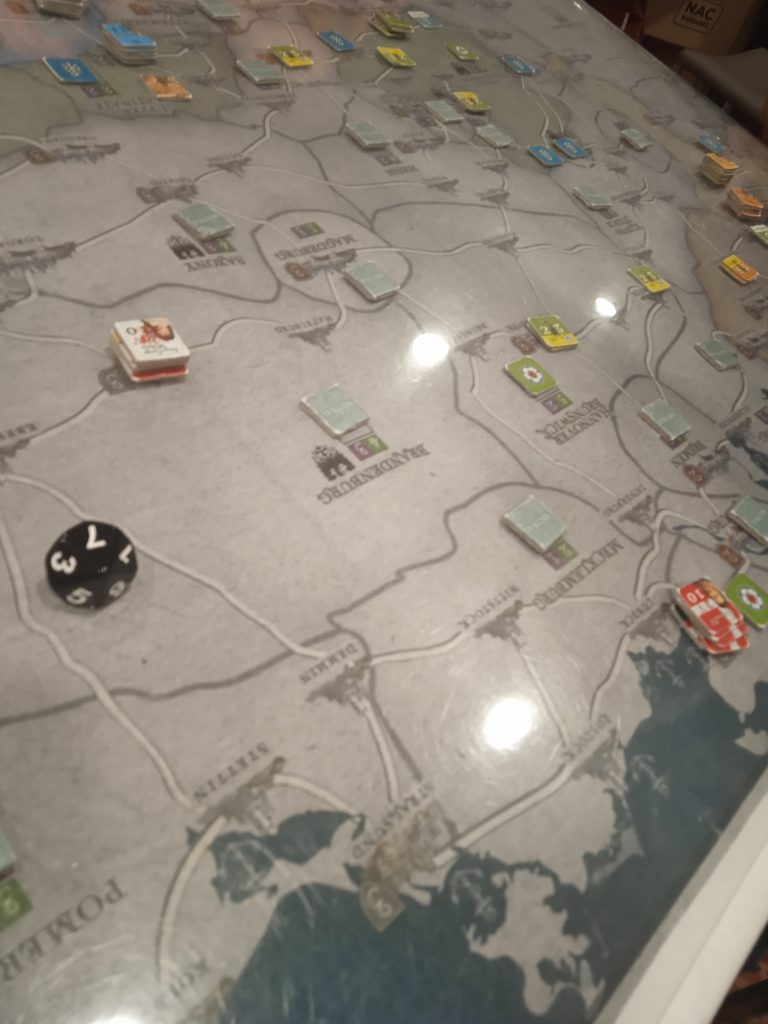
Inicio de acciones del Protestante
B. Movimientos del Católico en el norte-sur
El Católico busca realizar operaciones en la zona del norte-sur del ‘Sacro Imperio Romano-Germánico’.

Acciones del Católico
C. Evento usado por el Protestante
El jugador Protestante ha jugado por el evento la carta ‘Revueltas en la Baja y Alta Austria’, y reduce a la mitad las unidades del Católico en la región de Austria que en este caso solo son las que se encuentran en Viena.
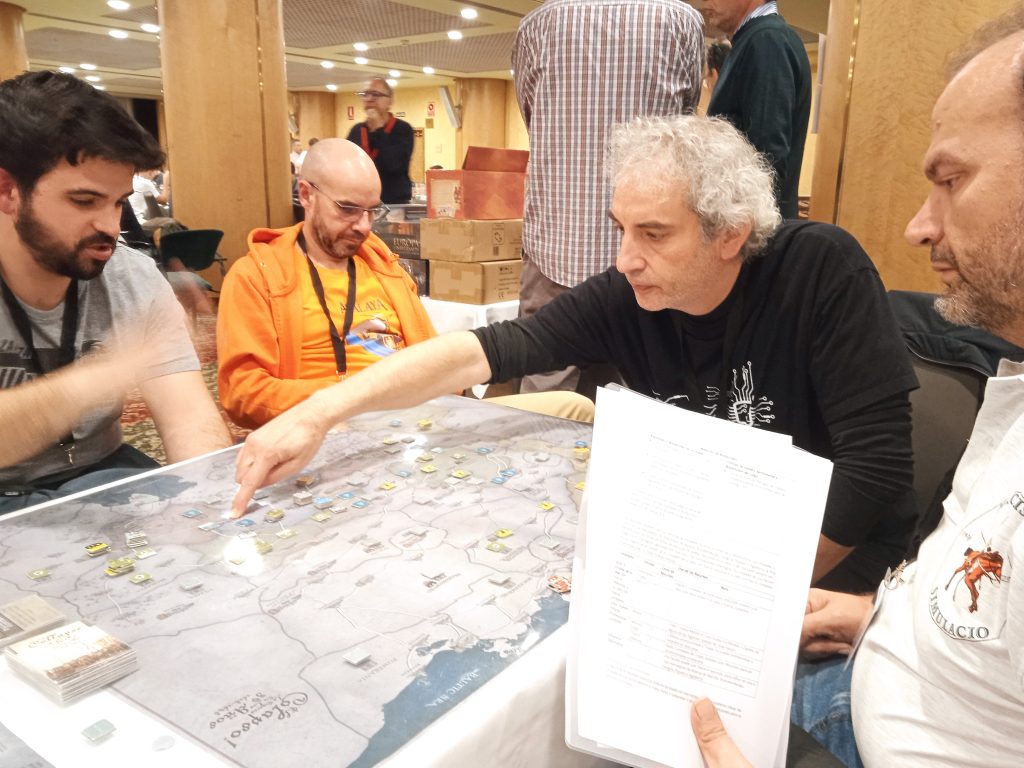
Reducción unidades católico en Viena
D. Batalla Mayor a las afueras de Viena, y reorganización del Protestante
El jugador Protestante en una acción posterior decide mover el ejército de Thurn desde Znojmo (en la región de Moravia) hacia Viena para realizar una Batalla Mayor (que tiene un coste de 3 puntos de operaciones, o con un evento que lo permita) contra el ejército católico de Hatzfeld.
El resultado de la batalla es una derrota católica y al ser una capital el Católico se retira al interior de la ciudad, incrementando su defensa de 4 a 6 (siendo 6 el mínimo de unidades del enemigo necesarias para asediar Viena). Como las bajas de la Batalla Mayor han sido elevadas, el Protestante no tiene el número mínimo de ciudades para asediar (tiene 5 en este caso).
Posteriormente el Protestante decide mover 2 unidades (milicias) del ejército de Gabriel Bethlen desde Pressburg a las afueras de Viena donde se une a Thurn, formando un ejército de 7 unidades (máximo posible según el límite de apilamiento). Como el ejército que asedia Viena de Thurn es igual o mayor que las unidades que defienden el asedio (en este caso son 6), se establece un asedio poniendo una ficha de asedio en su valor 0 y sufriendo desgaste con una unidad (en cada intento de asedio se tenga éxito o no, el atacante sufre desgaste de una unidad).

Final Batalla Mayor a las afueras de Viena
E. Revueltas en Hungría
El jugador Católico intenta reaccionar usando una capacidad de revuelta que ha adquirido durante la fase de planificación del inicio del turno, y sitúa dos revueltas en dos ciudades menores de la región de Hungría quitándole el control de la región al Protestante al no controlar el mínimo de ciudades. Es una estrategia interesante para intentar forzar al Protestante a destacar unidades a Hungría y eliminar las revueltas, y ver si el Protestante mantenía o no el asedio a Viena.
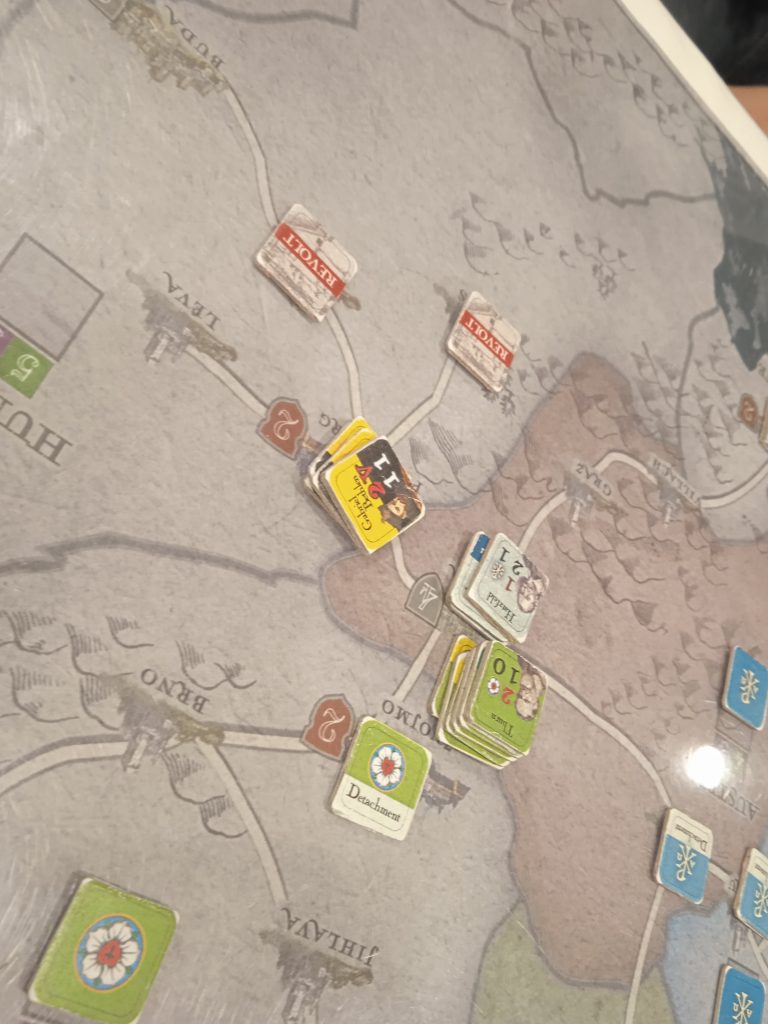
El Católico sitúa revueltas en Hungría
F. Intento de asalto del Protestante durante un asedio a Viena
En una ronda posterior el Protestante intentó un asalto con una operación de asedio a Viena … y falló la tirada! Viena se salvó por el momento! Posteriormente, el Católico desplazó al ejército de Bucquoy desde Bohemia para levantar el asedio a Viena y realizar una Batalla Mayor a las afueras de Viena (uniéndosele las unidades del ejército de Hatzfeld que se encontraban en el interior de Viena) y combatir al ejército de Thurn. La victoria fue para el Católico, y el ejército superviviente de Thurn se retiró a Pressburg donde se unió a las unidades que había dejado el ejército de Gabriel Bethlen al moverse a Viena.
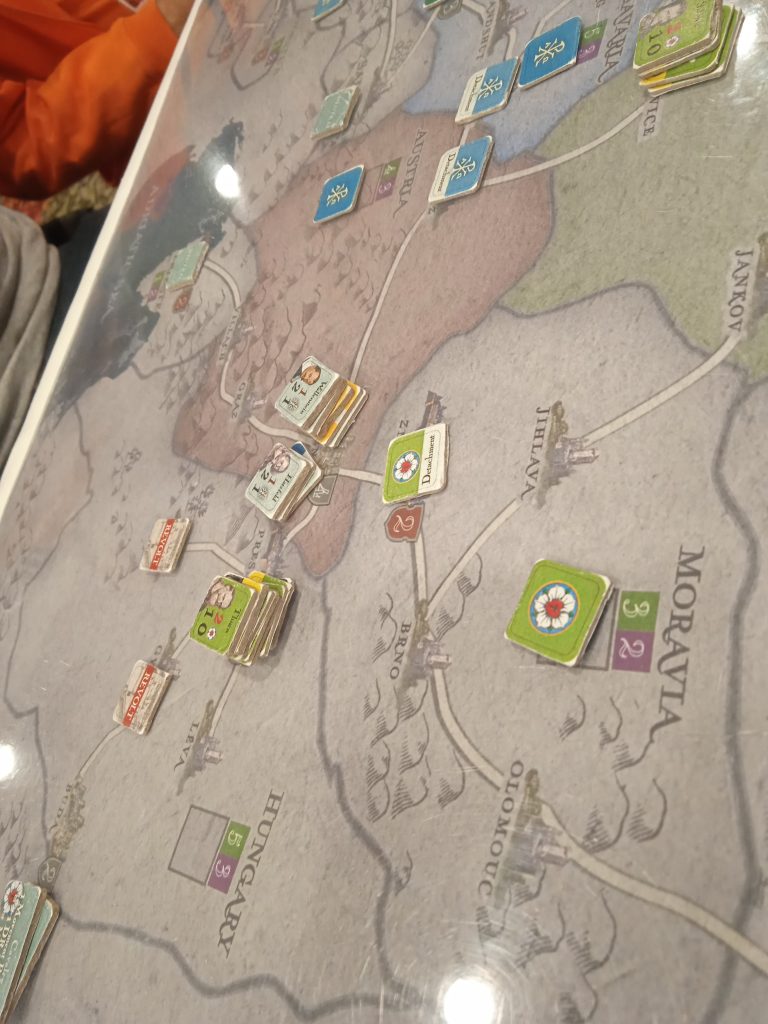
Resultado Batalla Mayor en Viena del contraataque católico
G. Movimiento de reacción Protestante
En un intento del Protestante de crear un ataque a las espaldas del Católico sabiendo que el ejército de Bucquoy ha abandonado Bohemia para defender Viena, el Protestante mueve al ejército de Cristian de Anhalt de Bohemia hacia Baviera donde saquea la región tomando ciudades menores esperando que el Católico retire hacia Baviera unidades que liberen la presión a Hungría. Además, decide mover al ejército de Cristian IV desde Kiel hacia las Provincias Unidades por movimiento naval (controla las ciudades de inicio y final, y consume todo su movimiento), planeando moverse desde allí en apoyo del ejército de Mauricio de Nassau y atacar tanto Flandes como la región del juego de Kleves-Jülich que se encuentra poco defendida.


Movimientos protestantes
H. Intento del Católico de reabrir el Camino Español
El Católico aguanta la presión protestante tanto en Baviera como desde las Provincias Unidades, y decide que es momento de intentar atacar Saboya para reabrir el ‘Camino Español’ y permitir el paso de los ‘Tercios’ españoles al final del turno.
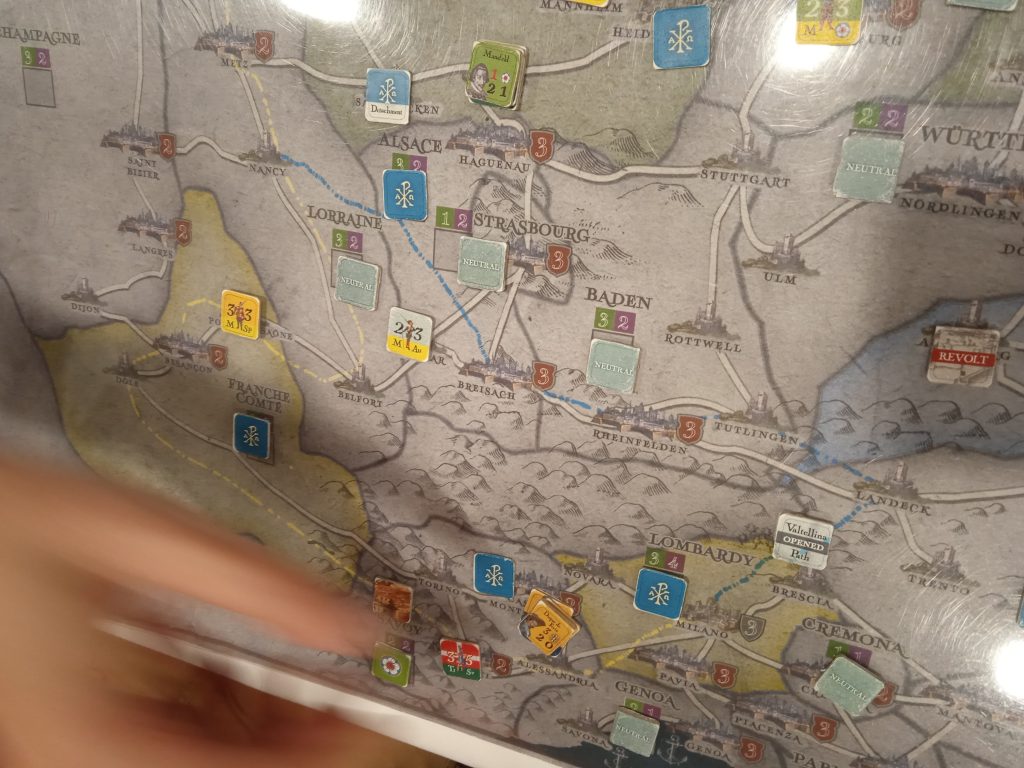
Ataque Católico a Saboya
I. Acciones finales y posibles opciones estratégicas para el próximo turno
Finalmente el Protestante ha movido unidades a las ciudades en revuelta de Hungría y retomado su control. Además, el Protestante consiguió la alianza por medio de la diplomacia de Brandenburgo (que no su control político) y entran del lado del Protestante, creando una presión hacia Bohemia que el Católico debe tener en cuenta en un turno próximo así como de la amenaza desde las Provincias Unidas donde se prevén movimientos lo que puede hacer necesario mantener al ejército de Spínola en Flandes.
El turno ha mostrado el control de algunas regiones, el crucial uso de la diplomacia, así como de acciones en varias regiones incluyendo un intento de asedio épico de Viena que ha resistido el Católico. El Protestante ha sido debilitado en Hungría y si presiona el católico puede caer la región … pero el Católico no puede perder de vista el resto del mapa. Muchas opciones estratégicas para ambas facciones, y mucha diversión en ‘El Colapso’!
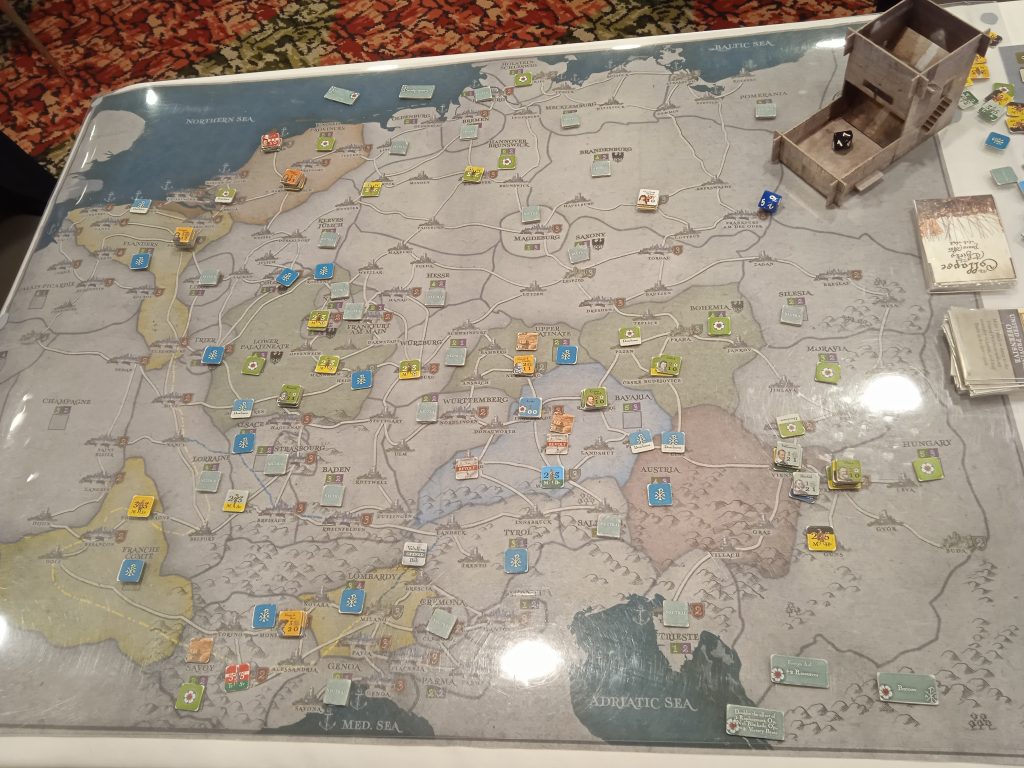
Final de turno
Estad atentos a próximas novedades y partidas de ‘El Colapso’.

‘El Colapso’
3. Apoyo a la publicación de ‘El Colapso’
‘El Colapso’ wargame estratégico sobre la guerra de los 30 años (1618-1648) después de un testeo intenso en convenciones de wargames y juegos de mesa y en vassal, está abierto el testeo en vassal a todas las personas interesadas.
Si estás interesado en conocer el juego y estar al tanto de las novedades y mucho más, entra en el link a continuación del canal de discord del blog ‘Mesa de Guerra’ y busca la pestaña de ‘El Colapso/The Collapse’ donde verás 3 pestañas para consultar:
Link del canal de discord de ‘El Colapso’: https://discord.gg/98h49WvwH8
#colapso: Información general del juego y novedades
#preguntas y respuestas: dejad vuestras preguntas o consultas del juego, y las iremos respondiendo
El Colapso: canal de audio/vídeo donde expondremos partidas en directo de ‘El Colapso’ y que anunciaremos con antelación
Si además de querer estar atentos a las novedades del juego, queréis participar en el testeo del juego ya sea en vassal o en físico, enviadme un mensaje privado en discord (danielhernandeziniesta) y os daré acceso al canal privado donde os podréis unir al grupo de testeo de ‘El Colapso’.
En el canal de discord podéis escribir tanto español como en inglés, y expondré toda la información y novedades del juego en ambos idiomas.
El juego está actualmente en reserva en la página web de NAC Wargames y Mas que Oca (sin compromiso), donde podéis apoyar la publicación del juego con vuestro registro en http://tinyurl.com/yfkkdbc3
Si os registráis en inglés (a la espera que la editorial abra una reserva en la web en inglés), seleccionad “apúntame” (regístrame en inglés) y sigue los pasos para la reserva, cualquier duda la podéis indicar en el canal de discord.
Es muy importante vuestro registro en la reserva del juego, para apoyar a que el juego se publique finalmente.
Si tienes alguna pregunta o quiere que amplíe un artículo o escriba sobre algo que le interese, hágamelo saber con un comentario sobre este artículo, envíame un correo electrónico a daniel.hndez@gmail.com y siga las noticias del juego en Twitter (@HndezDaniel) y Instagram (daniel_hernandez_iniesta)
No dudéis en consultar la página del juego en la BoardGameGeek en ‘The Collapse’: https://boardgamegeek.com/boardgame/389679/collapse
AUTOR DEL JUEGO: DANIEL HERNÁNDEZ INIESTA
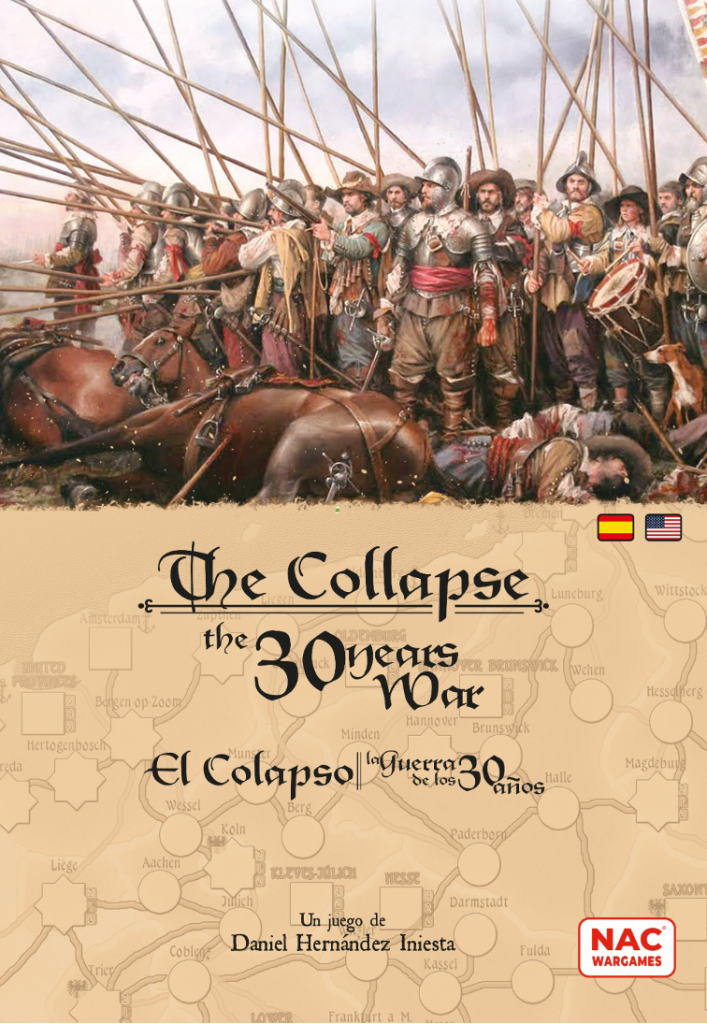
Cover photo: Art by Augusto Ferrer Dalmau
Para leer la versión en español de este artículo, por favor ve arriba en este artículo
1. Batalladores 2023 Convention
‘The Collapse’ is a wargame or historical simulation game designed as a strategic game for 2 players about the 30 years’ war (1618-1648), but with rules for multiplayer games that can be reserved without commitment at the link http://tinyurl.com/yfkkdbc3
At the past Batalladores convention held in the beautiful city of Zaragoza between the 3rd and the 5th of November and organized by the Batallador club for about 300 attendees and that we enjoyed with so many wargames, I presented the ‘The Collapse’ updates as well as the game ‘The Defense-The Siege of Cadiz 1625’. The game of ‘The Defense’ I designed with the fantastic art of Nils Johansson that we gave for free for the attendees at Pax Lúdica 2023 convention in Cádiz with Sergio from the blog Mesa de Guerra, and that we are working on an edition for the general public.

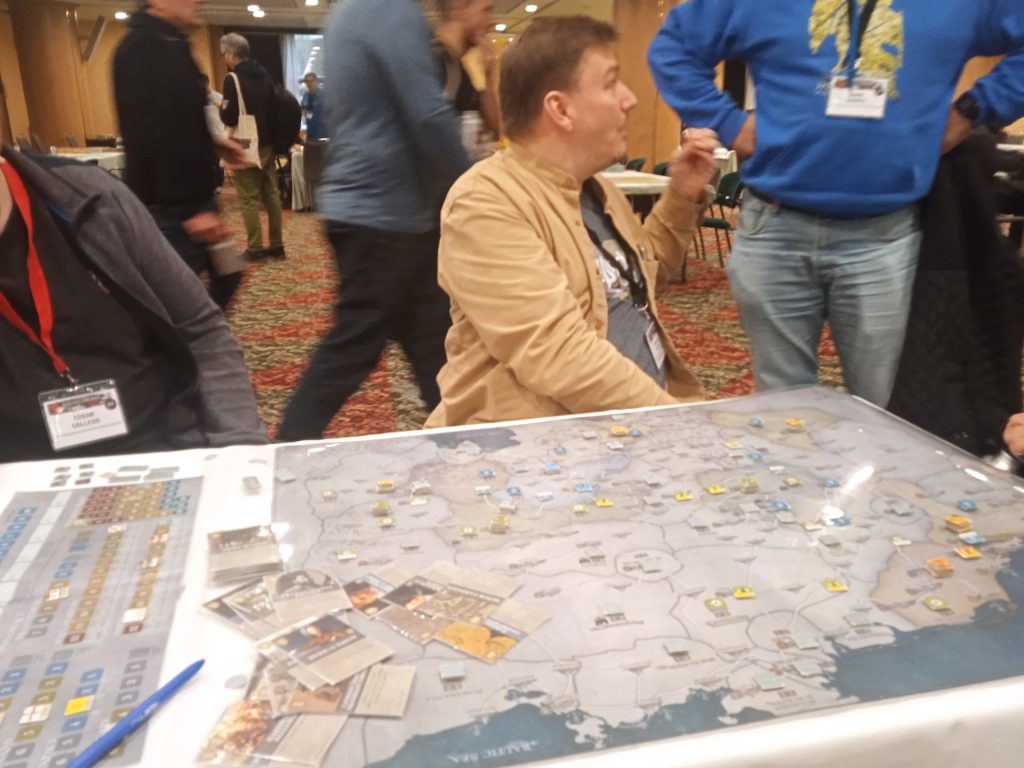

Photos of Batalladores 2023
At Batalladores 2023 I presented ‘The Collapse’ updates which is in an advanced prototype, with the mechanics ready and testing for some final adjustments while continuing to adjust values with live playtest and in vassal mainly for the full campaign (10 turns). Among other updates presented, I would like to highlight the artwork from the wonderful graphic artist Donal Hegarty on the map, diplomatic-administrative board, cards and counters.
I recommend for those who want to know more about the game to watch the last videos I recorded about the game with (videos in Spanish, but you can select YouTube translation):
– Gostilian: https://www.youtube.com/watch?v=SHAKpExFmCw&t=475s
– El Profe Bermejo:
(video part 1) https://www.youtube.com/watch?v=g3wBYqRM1-8&t=51s
(video part 2) https://www.youtube.com/watch?v=DYN-L3WdOH0&t=499s
You can also find these videos and other previous ones along with more information in the BGG page that I recommend you to visit: https://boardgamegeek.com/boardgame/389679/collapse
2. ‘The Collapse’ at Batalladores 2023


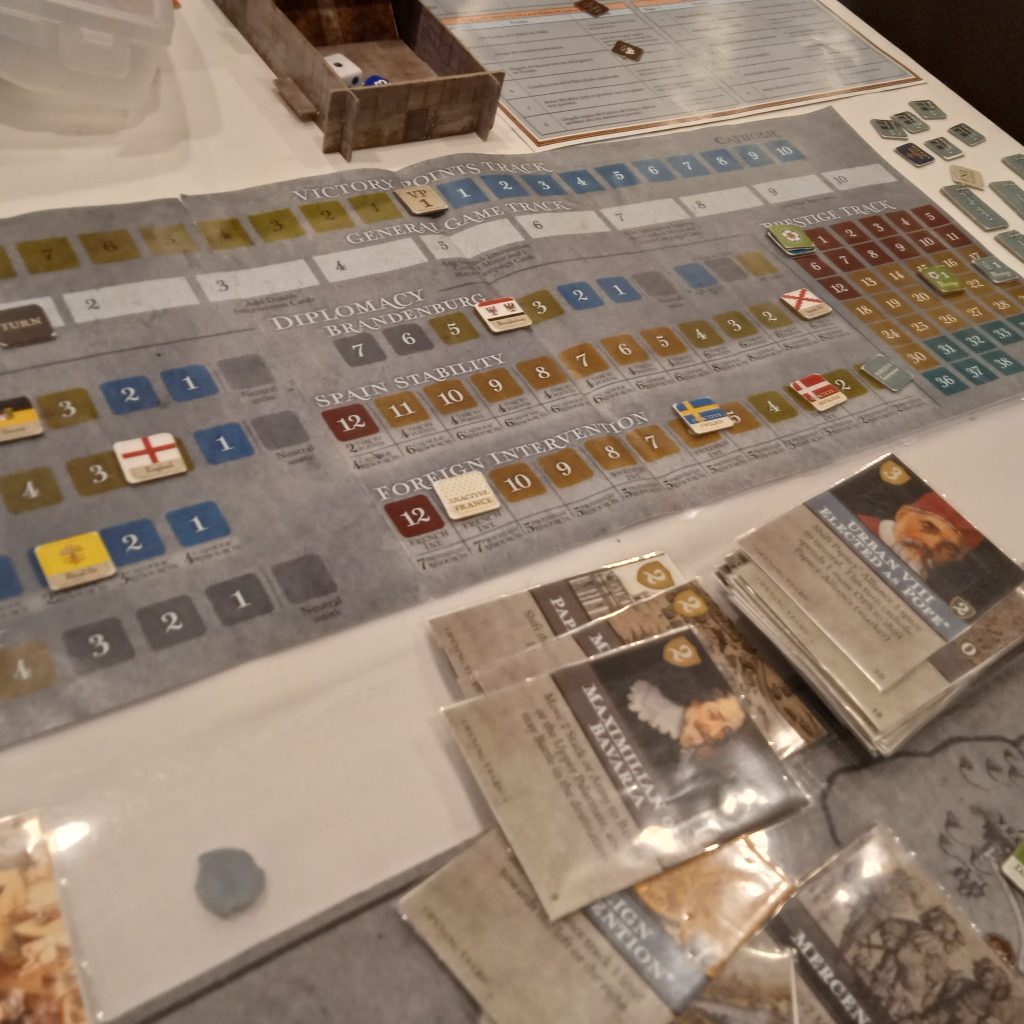

Pictures of ‘The Collapse’ in Batalladores 2023
During Batalladores 2023 I made several demo games of ‘The Collapse’ as well as answering questions from people interested in the game, but even more important was on Saturday when I organized a multiplayer game with 6 people (which will be a game option included in ‘The Collapse’).
TURN 1
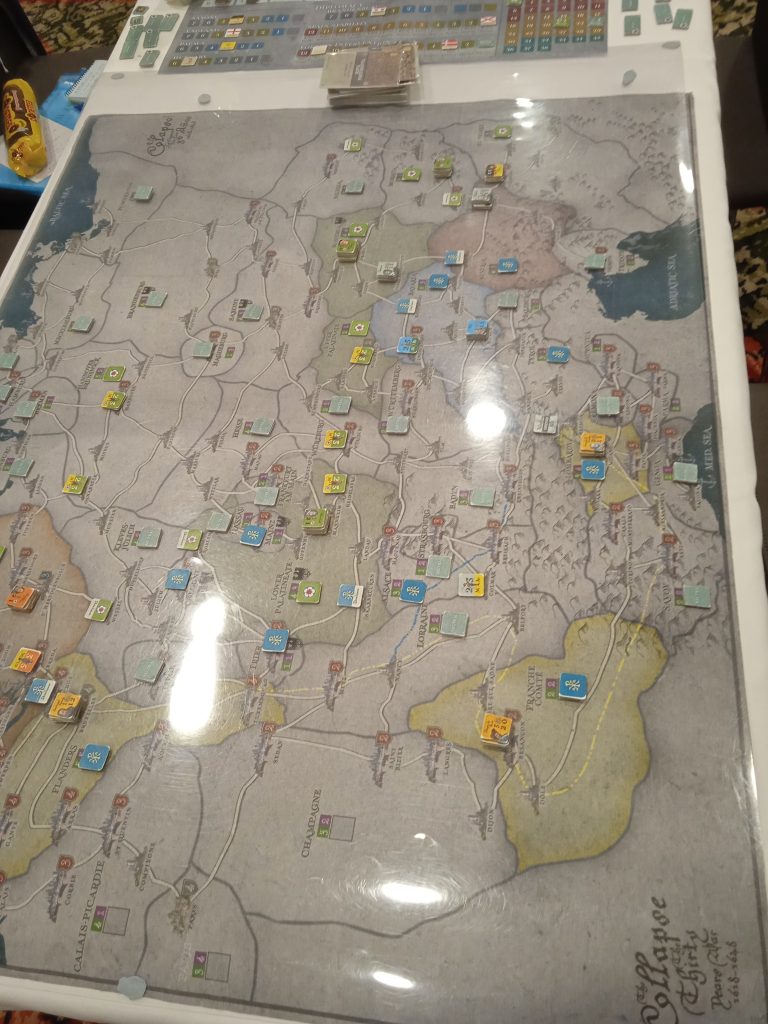
Beginning of the turn
In the first game’ turn, I presented how the game works by introducing progressively by difficulty the game’ rules. The goal of this action was to make it easier to players to grasp the game rules progressively while having fun. From turn 2 onward which I explain below, the players performed their actions by themselves and only asked me for doubts that they had.
At the start of the turn, you can see in the picture above the initial situation of the two factions where the Protestant has more control of the internal lines (but they have weaker armies), and the Catholic is located in more on the outside in not connected regions (but their armies are stronger).
TURN 2
Planning Phase
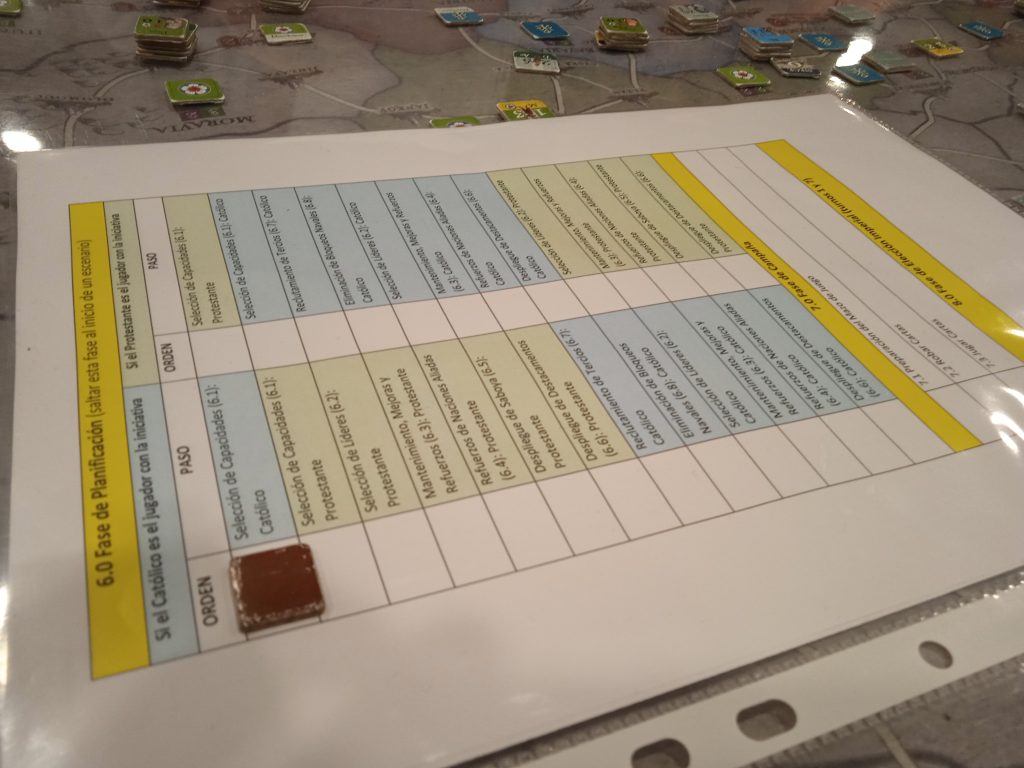
Planning Phase Tracking player’ aid card (playtest material)
In this phase of the beginning of the turn (planning phase), the players determine the actions that they will perform according to who has the initiative of the turn which in this case is the Protestant (the victory points counter at the end of the previous turn was in favor of the Catholic). This is a mechanic to slightly compensate the previous turn, and to have the initiative in this step and later decide if a player wants to initiate the actions in the campaign phase or prefers that will be performed first by the opposite player.
In each step of this phase as indicated in the player’ aid card the actions indicated according to the prestige level acquired the previous turn (low, medium or high) are performed, which determine how many actions can be chosen in each step. For example, if you have a medium prestige in the leader selection step you will be able to choose 1 leader to enter the game, but if you are in a low level none and in high 2 leaders.
Campaign phase
After dealing 6 cards to each player, the Protestant having the initiative of the turn decides to start the actions by playing first. In this section I will present the most important actions of the turn of both players, so you can see in a faster way and narrative how the game works and in a future article I will present a longer game playthrough.
A. Denmark enters into the game
The Protestant player in his actions decides to use a diplomacy operation (cost of 2 card operation points) and move the foreign intervention counter one space from 2 to 3 (in the previous turn it had been moved from 1 to 2). In this case, you reach the box where the alliance of Denmark is located and the leader Christian IV, 4 troops of Denmark and 2 Protestant mercenaries enter the map. In this case the first option to enter the Danish units according to the rules is Kiel annd they take control of the Holstein-Schleswig region of the game (adjusting the victory and prestige points for their control).
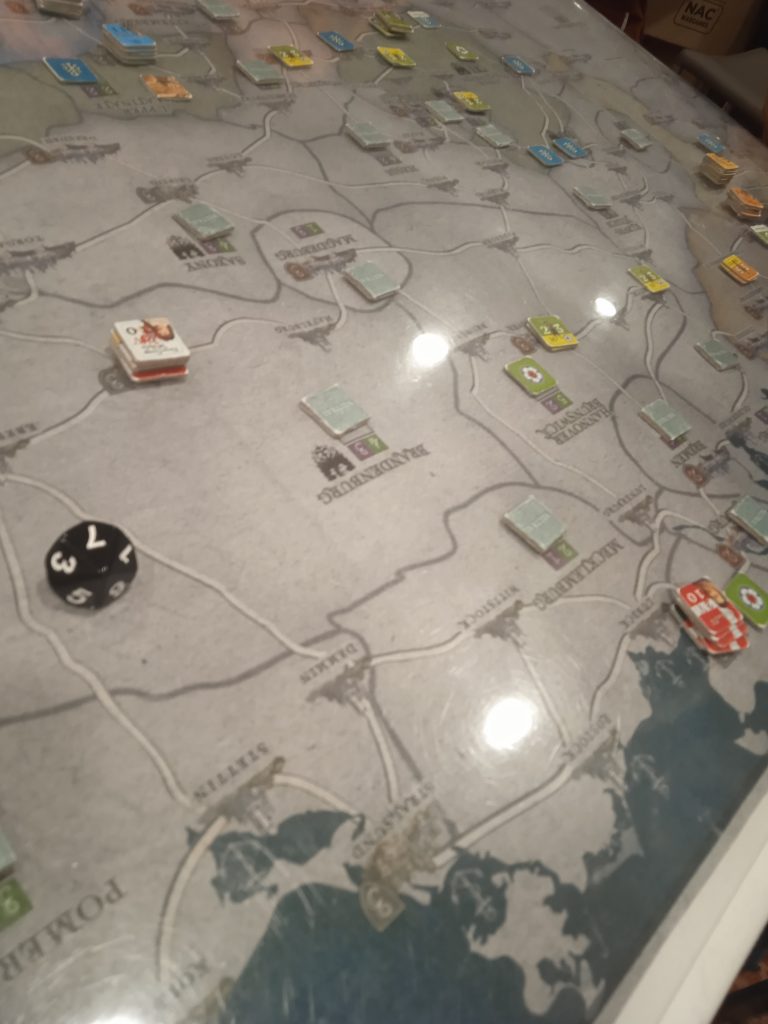
Beginning of Protestant actions
B. Catholic moves in the north-south
The Catholic seeks to perform operations in the north-south zone of the ‘Holy Roman-Germanic Empire’.

Catholic actions
C. Event used by the Protestant
The Protestant has played the event ‘Revolts in Lower and Upper Austria’, and halves the Catholic’s units in the Austrian region which in this case are only those located in Vienna.
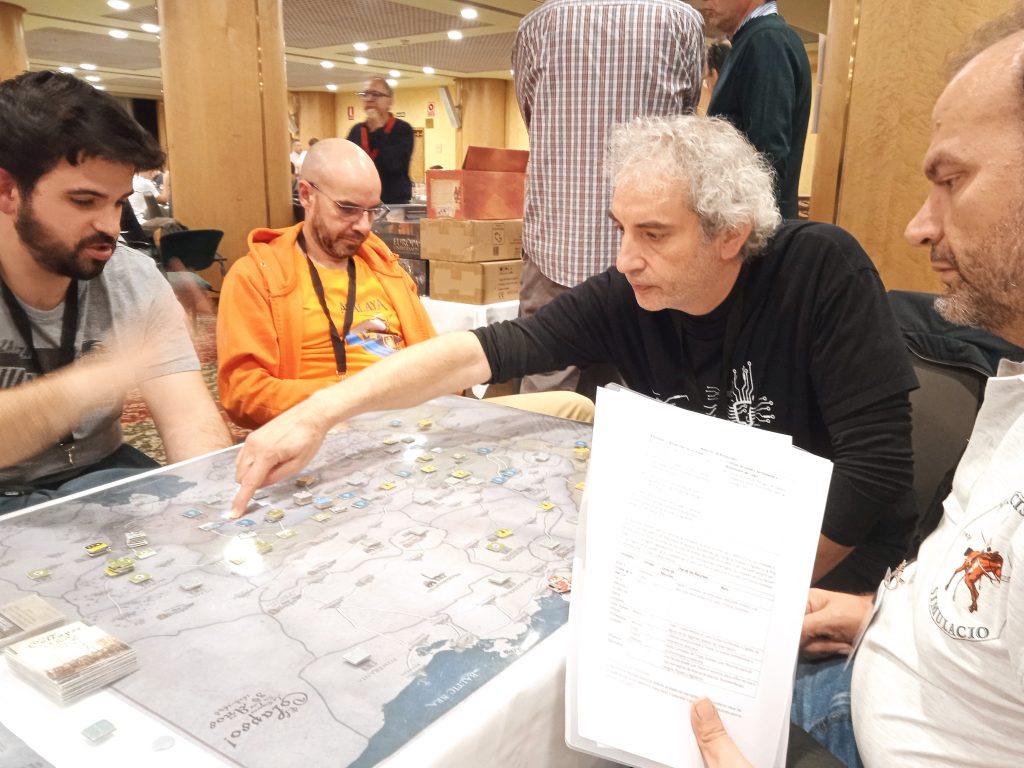
Catholic units halved in Vienna
D. Major battle outside Vienna, and Protestant reorganization
The Protestant in a later action decides to move Thurn’s army from Znojmo (in Moravia region) to Vienna in order to perform a Major Battle (which costs 3 operation points, or with an event that allows it) against Hatzfeld’s Catholic army.
The battle’ result is a Catholic defeat and since it is a capital, the Catholic retreats into the city, increasing his defense from 4 to 6 (6 being now the minimum number of enemy units needed to besiege Vienna). As the casualties of the Major Battle have been high, the Protestant does not have the minimum number of cities to besiege (it has 5 in this case).
Later on, the Protestant decides to move 2 units (militia) from Gabriel Bethlen’s army in Pressburg to the outskirts of Vienna where he joins Thurn, forming an army of 7 units (maximum possible according to the stacking limit). As the army besieging Thurn’s Vienna is equal to or larger than the units defending the siege (in this case 6), a siege is established by placing a siege counter on its 0 value and suffering attrition with one unit (in each siege attempt, successful or not the attacker suffers one unit’ attrition).
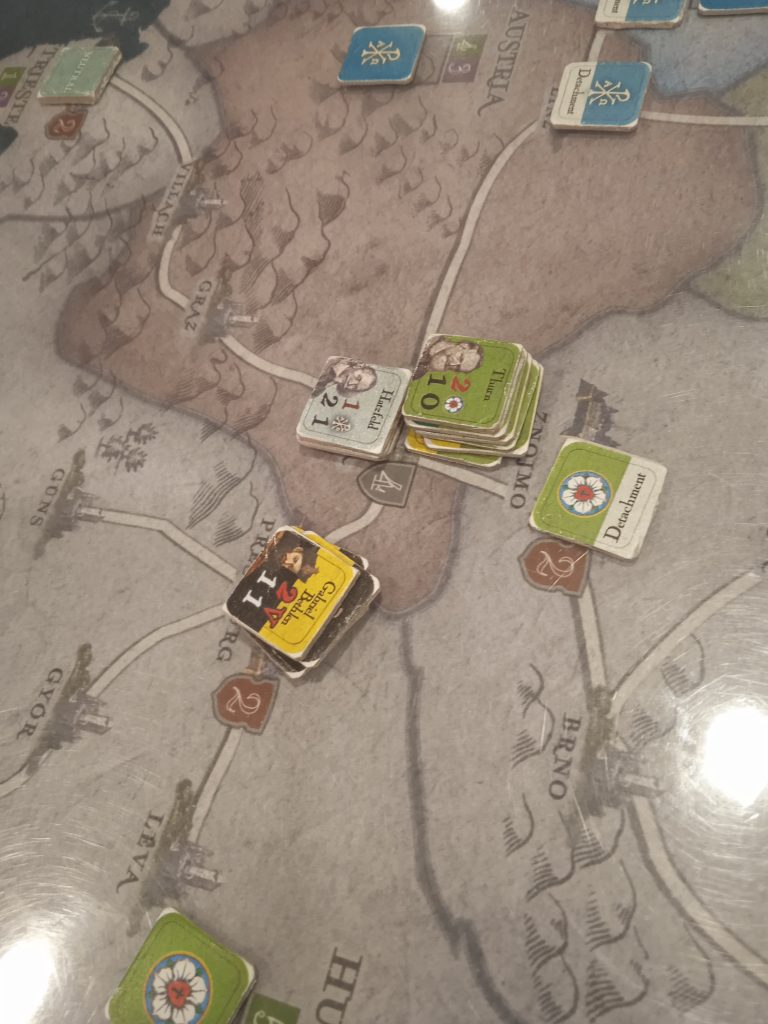
Final Major Battle on the outskirts of Vienna
E. Revolts in Hungary
The Catholic tries to react to the Protestant’ threat to Vienna using a revolt capability which was acquired during the planning phase at the beginning of the turn, and places two revolts in two minor cities in the Hungary region taking control of the region away from the Protestant by not controlling the minimum number of cities. It is an interesting strategy to try to force the Protestant to detach units to Hungary and eliminate the revolts, and to see if the Protestant maintains or not the Vienna’ siege.
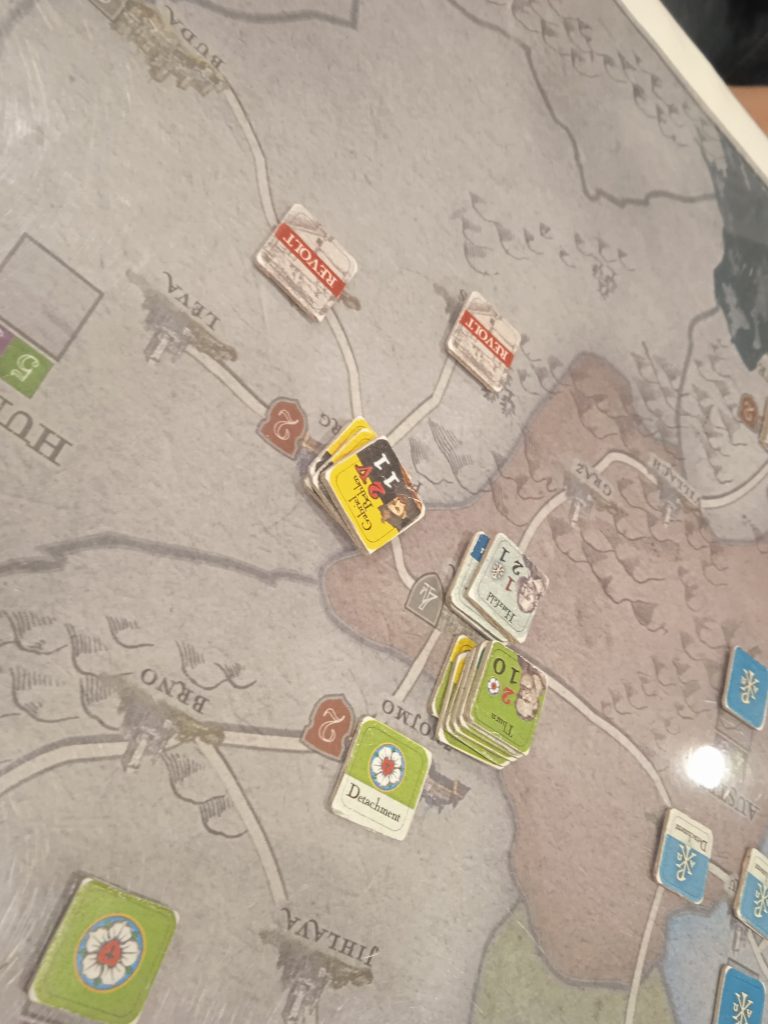
The Catholic places revolts in Hungary.
F. Protestant assault attempt during a siege of Vienna
In a later round the Protestant attempted an assault with a siege operation on Vienna … and failed the roll! Vienna was saved for now! Later on, the Catholic moved Bucquoy’s army from Bohemia with the goal to raise the siege of Vienna and conduct a Major Battle on the outskirts of Vienna (joined by units of Hatzfeld’s army inside Vienna) and fight Thurn’s army. The victory went to the Catholic, and Thurn’s surviving army retreated to Pressburg where it joined the units left by Gabriel Bethlen’s army as it moved previously into Vienna.
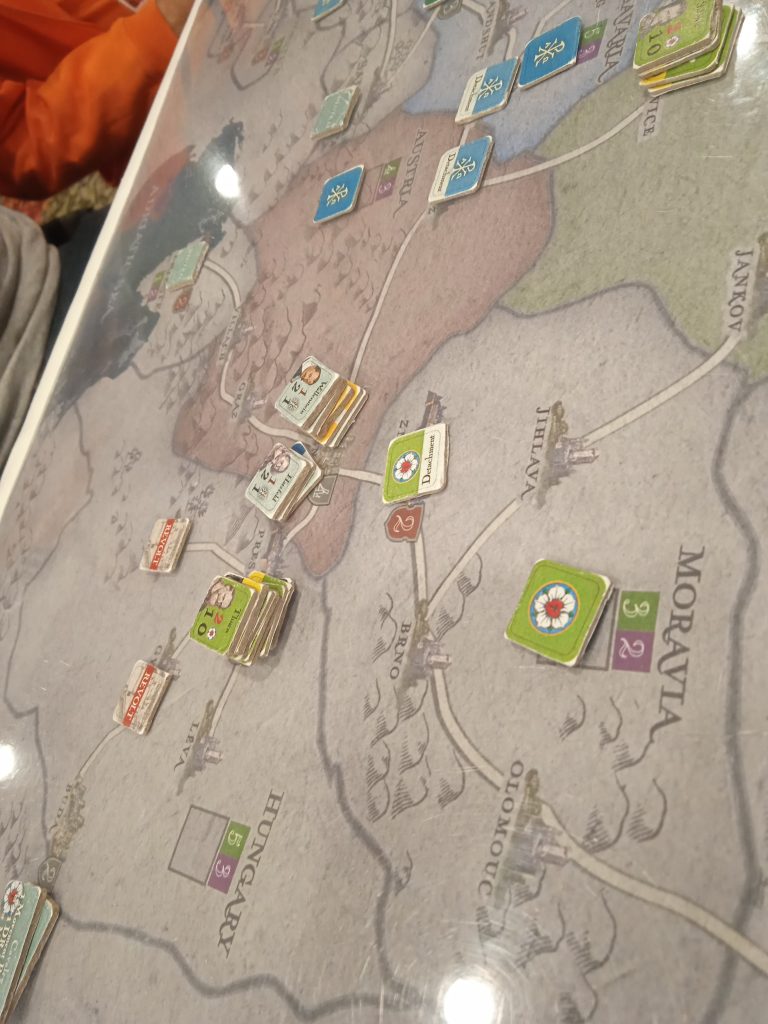
Major Battle result in Vienna of the Catholic counter-attack
G. Protestant reaction movement
The Protestant attempts to create an attack on the Catholic’s back knowing that Bucquoy’s army has left Bohemia to defend Vienna, so the Protestant moves Christian of Anhalt’s army from Bohemia into Bavaria where he ravages the region by taking minor cities’ control hoping that the Catholic will withdraw units into Bavaria to relieve the pressure on Hungary. In addition, he decides to move Christian IV’s army from Kiel to the Provinces Units by naval movement (he controls the start and end cities, and consumes all his movement), planning to move later from there in support of Maurice of Nassau’s army and attack both Flanders and the poorly defended Kleves-Jülich game region.


Protestant movements
H. Catholic’ attempt to reopen the Spanish Road.
The Catholic withstands Protestant pressure both in Bavaria and the United Provinces, and decides that it is time to try to attack Savoy to reopen the ‘Spanish Road’ and allow the Spanish ‘Tercios’ to pass at the end of the turn.
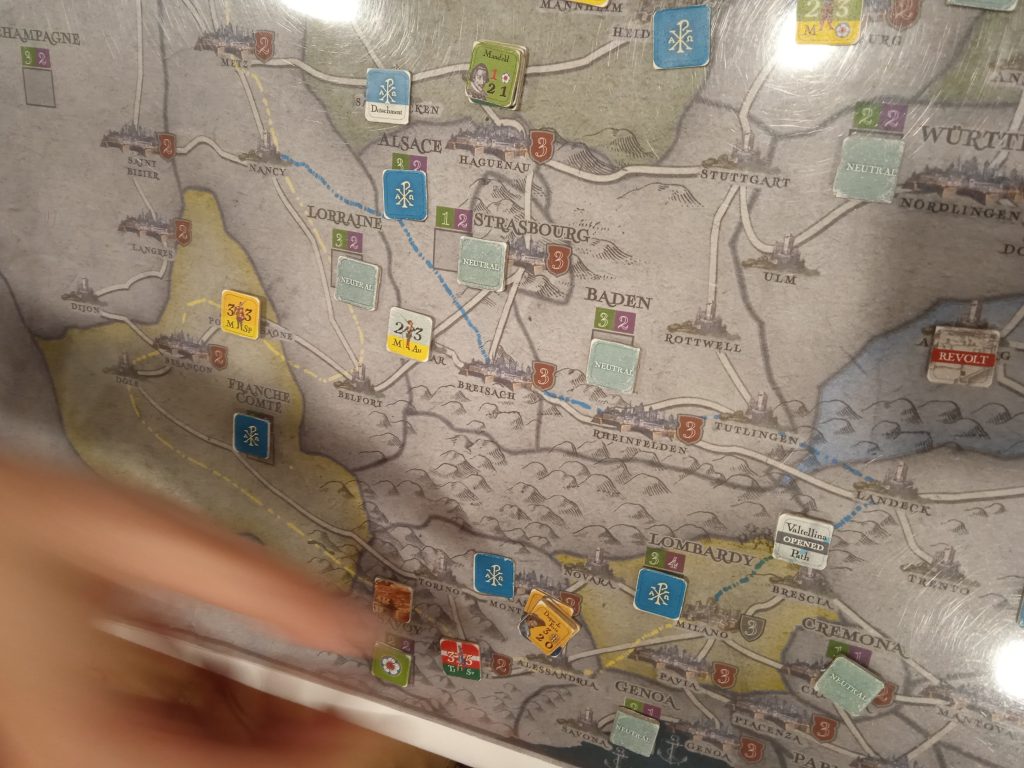
Catholic Attack on Savoy
I. Final actions and possible strategic options for the next turn.
Finally, the Protestant has moved units into the cities under revolt of Hungary and regained control of them. In addition, the Protestant got the alliance through Brandenburg’s diplomacy (but not his political control) and they enter on the Protestant side, creating a pressure towards Bohemia that the Catholic must take into account in the next turn as well as the threat from the United Provinces where movements are foreseen and may make it necessary to keep Spinola’s army in Flanders.
The turn has shown how to gain (and lose) region’ control, the crucial use of diplomacy, as well as actions in several regions including an epic siege attempt of Vienna with the Catholic holding the city’ control. The Protestant has been weakened in Hungary and if pressed the Catholic may fall the region … but the Catholic cannot lose sight of the rest of the map. Lots of strategic options for both factions, and lot of fun in ‘The Collapse’!

End of turn
Stay tuned for future news and games of ‘The Collapse’.

The Collapse
3. Support for the publication of ‘The Collapse’
The Collapse’ strategic wargame about the 30 years’ war (1618-1648) after an intense testing in wargames and boardgames conventions and in vassal, the testing in vassal is open to everyone interested.
If you are interested in getting to know the game and keep up to date with the latest news and much more, go to the link below to the ‘Mesa de Guerra’ blog discord channel and look for the ‘El Colapso/The Collapse’ tab where you will see 3 tabs to check out:
‘The Collapse’ discord channel link: https://discord.gg/98h49WvwH8
#collapse: General game information and game updates.
#questions and answers: leave your questions or doubts about the game, and we will answer them as soon as possible.
The Collapse: audio/video channel where we will show live games of ‘The Collapse’, that we will announce in advance.
If you want to be updated about the game development and also want to participate in the game playtest either in vassal or physical, send me a private message in discord (danielhernandeziniesta) and I will give you access to the private channel where you can join ‘The Collapse’ playtest group.
In the discord channel you can write in spanish and english, and I will post all the information and news about the game in both languages.
The game is currently on pre-order on the NAC Wargames and Mas que Oca websites (no strings attached), where you can support the publication of the game by registering at http://tinyurl.com/yfkkdbc3.
If you register in English (waiting for the publisher to open a specific reservation on the website in English), select «apúntame» (register me in English) and follow the steps for the reservation, any doubt you can indicate it in the discord channel.
It is very important your registration in the reservation of the game, and support the game to be finally published.
If you have any questions or want me to expand an article or write about something that interests you, let me know with a comment on this article, send me an email to daniel.hndez@gmail.com and follow the game news on Twitter (@HndezDaniel) and Instagram (daniel_hernandez_iniesta).
Feel free to check out the game’s page on BoardGameGeek at ‘The Collapse’: https://boardgamegeek.com/boardgame/389679/collapse
GAME DESIGNER: DANIEL HERNANDEZ INIESTA

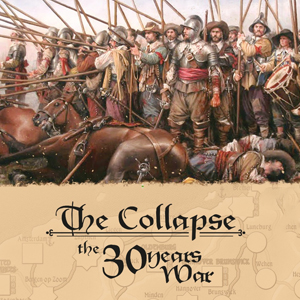
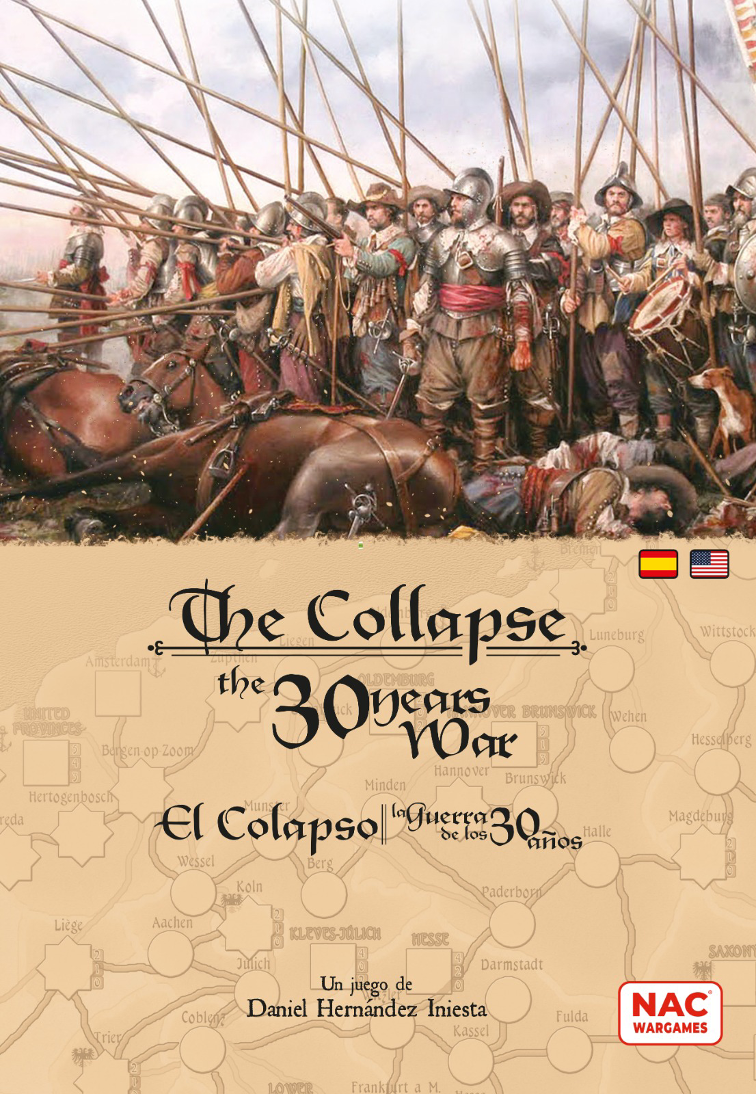
Buenos dias!
¿hay alguna actualizacion? Parece que el diario lleva casi un año parado 🙁
Hola Ricardo,
Muchas gracias por tu interés. El juego se ha seguido desarrollando y actualizo información constantemente cuando hay novedades en redes (X, instagram y Facebook), pero volveré a escribir en los diarios próximamente. Sobre ‘El Colapso’ la propia editorial anunció en sus últimos programas en Twitch (‘búnker’ como se llaman), que el juego ya está cerca de entrar en revisión final de reglas y posteriormente de producción.
El juego no se ha parado de trabajar en el testeo y desarrollo (tanto del propio juego, mecánicas, etc. como del arte gráfico que está realizando una maravilla Donal Hegarty) desde 2020 cuando inicié su diseño, y lleva más de 400 reservas en el p500. Si te interesa participar en el testeo o cualquier apoyo al juego no dudes en en escribirme a mi e.mail (daniel.hndez@gmail.com) y te responderé lo más rápido posible. No dudes que el juego va a quedar genial, y agradezco a toda la gente me está ayudando tanto en el testeo como en otros aspectos del juego.
Un saludo. Daniel Hernández Iniesta (diseñador de ‘El Colapso’)